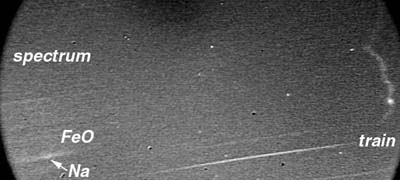|
Leonid MAC |
| home |
| View the shower |
| Mission Brief |
| Science Update |
| Media Brief |
| links |
LEONID DAILY NEWS: November 26, 2001
 PERSISTENT TRAIN EMISSION Not one, but several persistent trains were captured in low-resolution spectra by Czech astronomer Dr. Jiri Borovicka, who obtained similar results during the 1999 Leonid MAC mission. Dr. Borovicka observed from our ground site at Mount Lemmon Observatory near Tucson, Arizona. The spectrum in the figure is from the bright fireball that was reportedly seen in the night prior to the Leonid storm at 12:57 UT (Nov. 17). It shows the zero-order image to the right and the first order spectrum to the left. As before, the spectrum shows an emission line from sodium and a broad molecular band emission that was identified as the "orange arc" emisison of FeO based on observations from the 1999 Leonid MAC mission and laboratory analysis by Dr. John Plane of the University of East Anglia. In addition, there is strong emission at longer wavelengths in the red and near-IR. Dr. Borovicka also obtained spectra at an earlier phase, showing numerous lines caused by the recombination of ions and electrons. This is a newly recognized phase in meteor spectroscopy. More results can be found at Dr. Borovicka's Leonids 2001 site. 2001: Nov 26 - Near-IR persistent train emission Nov 24 - Results of near-real time flux measurements Nov 22 - Wowh! Optical meteor spectra 2000: Dec. 25 - Ursid shower circular IMO Dec. 24 - Ursid shows early release of sodium Dec. 23 - Ursid outburst confirmed Dec. 18 - Dec 22 Ursid outburst Nov. 20 - A bacterial fingerprint? Nov. 15 - HCN disappears mysteriously Nov. 14 - Meteor shower from space Nov. 13 - Organic fingerprint Nov. 12 - Train airglow chemistry Nov. 11 - Hard bits and persisting glows Nov. 10 - Meteoroid debris detected Nov. 09 - New meteor picture Nov. 08 - Spin city Nov. 07 - Meteors affect atmospheric chemistry Nov. 06 - Listen to this! Nov. 04 - Fear of heights? Nov. 03 - The pale (infra-red) dot Nov. 02 - Twin showers Nov. 01 - Leonids approaching Earth Oct. 31 - Prospects for Moon Impact Studies Oct. 30 - Comet dust crumbled less fine Today's news
| ||

